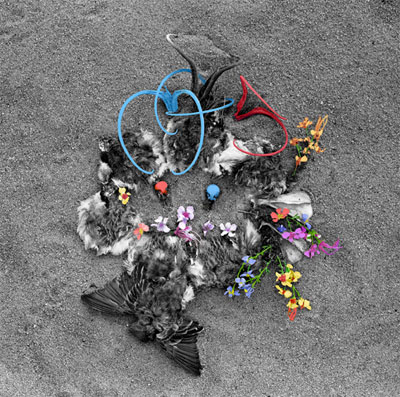Victor Masayesva
Drought
August 18 - September 25, 2006 |
Andrew Smith Gallery celebrates Indian Market 2006 with an exhibit titled Drought by Hopi photographer, Victor Masayesva, Jr., with an opening reception for the artist on Friday, August 18 from 5 to 7 p.m. Victor Masayesva, Jr., who lives in Hopi, Arizona, is a distinguished photographer and filmmaker known for blending traditional photographic techniques with digital imaging, drawing, hand coloring and collage. Over the years he has focused on the struggles of Native People to retain their identity, culture and spirituality against enormous obstacles. Masayesva's earlier bodies of work have explored such issues as reappropriation, government encroachment on sacred sites, historical biases, environmental destruction, and limitations of human perceptions and sensitivity. Drought deals with the Southwest's ongoing severe drought of 2006 and its impact on Hopi communities who depend solely on rainfall to grow their crops. Although Masayesva does not directly address the subject of global warming, its ramifications cannot but be underscored. Masayesva creates digital collages from an amalgamation of stories, symbols, natural objects and actual places. He brings to this body of work insights from the fields of biology, ecology, humanity, history, and planetary energy, along with concepts and traditions from the Hopi people. Rooted in Hopi cosmology, Masayesva explores a devastating reality meaningful to all people. Drought is Masayesva's fifth show at Andrew Smith Gallery. The exhibit continues through September 26, 2006. Masayesva will be signing copies of his new book Husk of Time: The Photographs of Victor Masayesva, published by the University of Arizona Press: Tucson, 2006, with an introduction by anthropologist Beverly R. Singer from Santa Clara Pueblo. Husk of Time chronicles thirty years of photographs by Masayesva. It includes essays by him that ponder such subjects as sovereignty and sacredness; the relationship between language, images and text; recent wars in the Middle East, and Hopi experiences and prophecies about famine, drought, disease and death. In his essays Masayesva draws on his own memories and stories passed down by elders, family and friends. He describes growing up in Hoatvela (Juniper Slope), a place where "you carried wood chips and bark with you when you were very young, branches as you grew stronger. When you reached adolescence you cut and carried wood. When you started your family you hauled piñon and juniper logs from miles away. When you reached old age you carried a wood cane . . ." Masayesva introduces readers to a honakti, (a woman who lost her mind), an uncle who instructed him to nawakna, (pay respect to everything upon waking up), and an apocalyptic figure called Pahana who first purifies the world before ushering in a peaceful age. The photographs track Masayesva's art making from the early 1970s to the present. The Hopis' survival has always depended on prayers for favorable weather conditions. For over 1,300 years the Anasazi and later the Hopi have inhabited a region of high, arid mesas where rain fall averages less than 10 inches a year. No constant rivers or streams flow through the territory, though a few permanent springs provide the people with drinking water. In times of drought survival becomes marginal. Although there have been droughts before, the drought of 2006 is the worst in memory. No crops survived spring planting this year, a fact that would have meant starvation in the past. In the present it may mean a further alienation from life giving forces. HISAT SINOM (ANCIENT) In "Hisat Sinom (Ancient)" Masayesva evokes the memory of a massive drought that occurred in the southwest in the 1200s when many ancient villages were abandoned. He photographed the Hisat Sinom ruin at Mesa Verde, perched in a massive cliff ledge, contrasting remnants of houses and storage units with a cluster of basket-shaped swallow's nests. Mesa Verde, a place of empty containers, is an image of abandonment. SNOWING In early spring 2006 Masayesva photographed a Hopi Buffalo Dancer, a man dressed as a spirit, who dances in winter to bring snow and rain for spring planting. In the photograph the dancer is depicted in colorful turquoise and white paint that contrasts with the warm brown skin of his bare chest. His white skirt is embellished with red and black. His feet are clad in brown deer skin boots that prance over the ground. This magical being dances next to a black and white scene of massive stone walls and a snow covered embankment. The snowflakes emanating from his body evoke snow for the spring planting. TUMOALA MOTIFS CRADLE PAMATORO (SPLASH) BIRD FLOWERS, SPRING 2005 MUYINGWA TUOI/ CORN STACK Masayesva grew up in Hotevilla, Arizona, on the Hopi Third Mesa. He attended the Horace Mann School in New York City in his teens, and then studied English literature and photography at Princeton University. In 1982 he became director of the Ethnic Heritage Program at Hotevilla, where he worked with the community youth and elders to record Hopi cultural history. Currently Masayesva is working on a film about Hopi runners who make annual pilgrimages to Mexico, a place they connect to water and to their ancestral beginnings. Liz Kay |